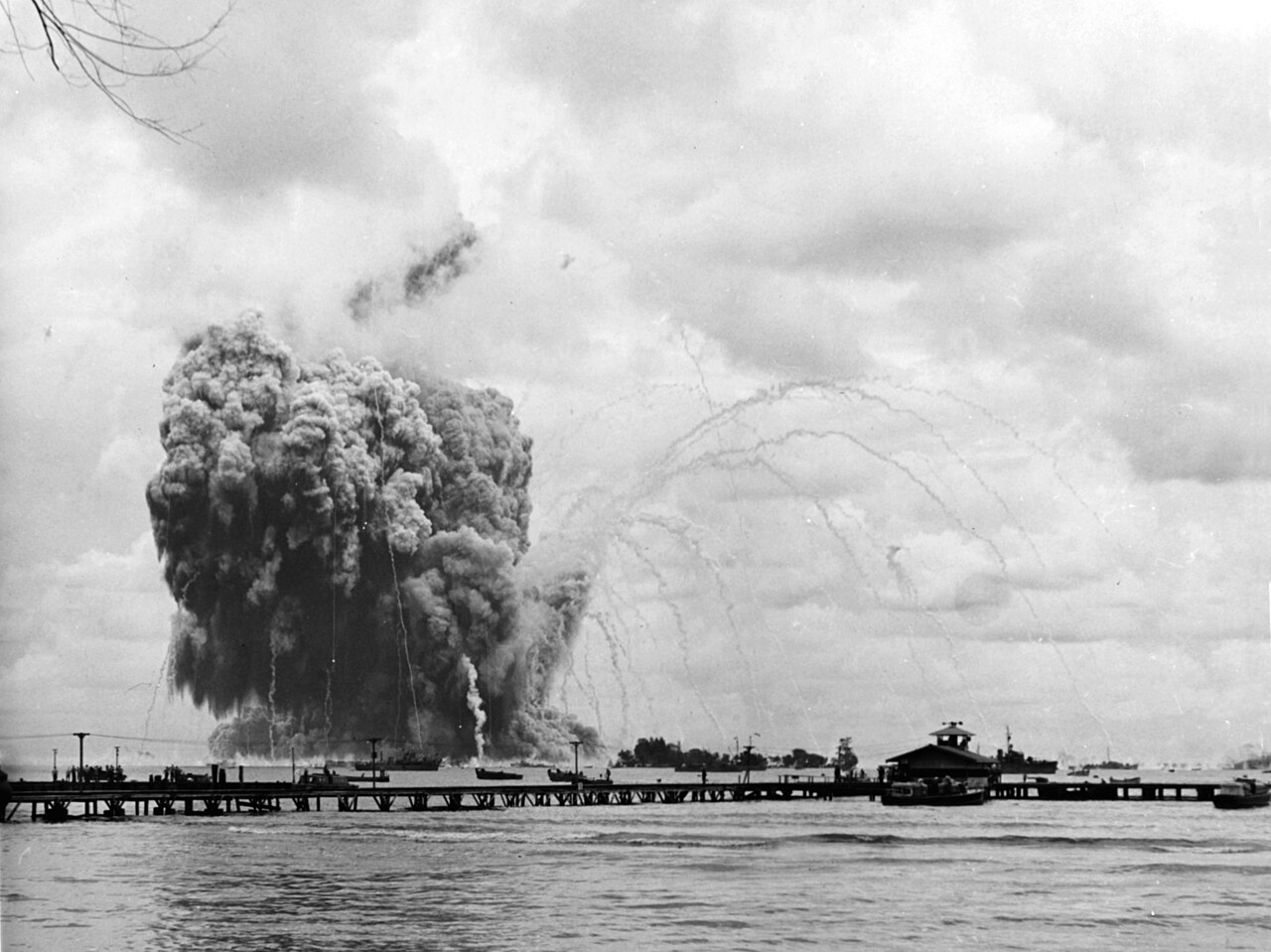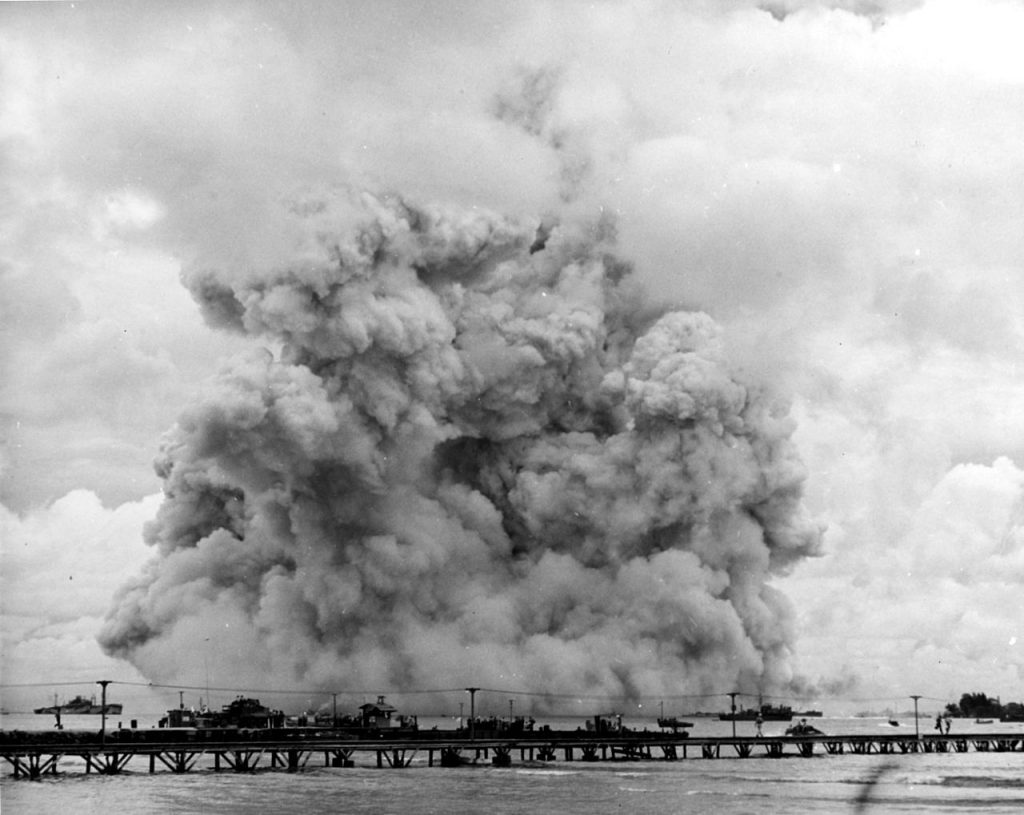On November 10, 1944, the USS Mount Hood, an ammunition ship anchored in Seeadler Harbor, Manus Island, spontaneously exploded, resulting in one of the most catastrophic non-combat-related disasters in U.S. Navy history.

The explosion was so massive that it completely obliterated the ship, leaving no survivors from the crew on board, and caused extensive damage and casualties on nearby ships and onshore facilities.
The cause of the explosion remains undetermined, but it highlighted the inherent dangers of handling large quantities of munitions and led to significant changes in naval safety protocols.
Background Of USS Mount Hood
The USS Mount Hood (AE-11) was an ammunition ship in the United States Navy during World War II, named after the prominent Mount Hood, a stratovolcano in the Cascade Range in Oregon.
This naming followed the U.S. Navy’s tradition of naming ammunition ships after volcanoes.
Commissioned on July 1, 1944, under the command of Captain Harold A. Turner, the USS Mount Hood was a relatively new vessel at the time of its destruction.
The ship was constructed at the North Carolina Shipbuilding Company in Wilmington, North Carolina, and was launched on November 28, 1943.
 USS Mount Hood pictured 15 days after she was commissioned.
USS Mount Hood pictured 15 days after she was commissioned.
As an AE-class ship, its primary role was to transport, handle, and deliver ammunition and explosives to various naval operations, a task of immense importance during the ongoing conflicts in World War II.
This role was especially critical as the Allied forces were intensifying their efforts in the Pacific Theater, requiring a steady and reliable supply of munitions.
The AE-11 was part of a larger fleet of ammunition ships designed to meet the demands of a global conflict.
These ships were essentially floating arsenals, carrying everything from small arms ammunition to large-caliber gun shells and bombs.
The design of such ships prioritized storage capacity and safety, with features intended to minimize the risk of accidental explosions.
However, the volatile nature of their cargo always carried an inherent risk, especially when operating in war zones.
Prelude To The Disaster
In the days leading up to the catastrophic explosion of the USS Mount Hood on November 10, 1944, the ship was engaged in routine but crucial operations within Seeadler Harbor, Manus Island, in the Admiralty Islands.
This period, characterized by intense naval activity, set the stage for one of the most tragic accidents in the history of the U.S. Navy.
Seeadler Harbor, a large natural harbor located on Manus Island, was a hive of Allied naval activity.
It served as a significant operational base in the Pacific Theater, providing support for the U.S. Navy’s island-hopping campaign against Japanese forces.
The harbor’s strategic location made it an ideal staging and supply point for naval units. This meant a constant flow of ships, including battleships, aircraft carriers, destroyers, and support vessels, coming in to resupply, refuel, and undertake repairs.
The USS Mount Hood, as an ammunition ship, played a pivotal role in these operations.
Its mission was to receive, store, and transfer a large array of munitions required by various ships in the Pacific fleet.
The ship’s manifest added up to roughly 3,800 tons of a wide variety of ordnance.
This included: naval shells ranging from 5 inch up to 14 inch and their accompanying powder charges, 30 calliber, 50 calliber and 20 mm rounds, 100 and 250 pound bombs, and depth charges.
On the morning of the explosion, the Mount Hood was bustling with activity. Additional ships were anchored nearby, awaiting their turn to receive ammunition.
The atmosphere in the harbor was one of organized chaos, typical of a wartime logistics hub.
At 8:30 AM, 17 members of the ships crew were on their way to the shore to collect the ships mail – 2 were also on their way to the brig to be court marshalled.
The ship had all hatches open, recieving 500 pound bombs.
Then disaster struck…
The Mount Hood Explosion
At 8:55 AM, the USS Mount Hood spontaneously exploded. The incident was unforeseen and abrupt, giving no warning to the crew aboard the ship or the personnel on nearby vessels and on the shore.
This suddenness contributed significantly to the high casualty rate, as there was no opportunity for evacuation or for taking emergency measures.
The explosion was colossal, completely obliterating the Mount Hood. Witnesses described a massive upheaval of water and a towering 7,000 ft column of smoke and fire.
The force of the blast was so immense that it was felt over miles away.
 The massive explosion from the 3,800 tons of ordnance on board.
The massive explosion from the 3,800 tons of ordnance on board.
The ship, carrying about 3,800 tons of munitions, essentially functioned like a gigantic bomb. The resultant shockwave devastated nearby ships and facilities, causing secondary explosions and fires.
The immediate vicinity turned into a scene of devastation. Ships close to the Mount Hood were severely damaged or destroyed.
The blast caused a rain of metal and debris, some of which were pieces of the Mount Hood itself, to fall over a wide area, causing further injuries and damage.
The destruction was not limited to naval assets. The explosion severely impacted the harbor’s infrastructure, including docks, warehouses, and other facilities essential to the naval operations in the area.
The concussion and subsequent shockwaves shattered windows and caused structural damage even to distant buildings.
Several ships in the vicinity suffered significant damage. Some of these vessels reported heavy casualties, and many were left with severe structural damage, rendering them inoperative.
Smaller ships, being closer to the blast, were more susceptible to the shockwave and debris.
The damage extended to vessels that were anchored as far as 2,000 yards away from the Mount Hood.
 The smoke cloud spreading after the explosion.
The smoke cloud spreading after the explosion.
All 350 men aboard the Mount Hood were instantly killed, and there were numerous casualties on nearby ships and on the shore.
The only survivors from the Mount Hood were the 17 men that left the ship to head to shore.
The exact number of total fatalities from the incident was difficult to determine due to the extensive nature of the destruction and the fact that personnel were scattered across multiple locations within the harbor.
Investigation And Speculation
Immediately following the explosion, the U.S. Navy launched a thorough investigation to determine the cause.
This investigation involved interviewing survivors, examining the wreckage of nearby ships, and analyzing the pattern of destruction in and around Seeadler Harbor.
The aim was to piece together the events leading up to the explosion and understand what could have triggered such a catastrophic event.
The primary challenge in the investigation was the total destruction of the USS Mount Hood.
With the ship itself disintegrated and no survivors from its crew, there were no direct witnesses to the initial moments of the explosion.
This lack of direct evidence significantly complicated the investigation, leaving the team to rely on secondary accounts and physical evidence from the surrounding area.
Several theories emerged during and after the investigation:
One prevalent theory was that static electricity or friction might have accidentally ignited the munitions.
The handling and movement of large quantities of ammunition could potentially generate static electricity, which, under unfortunate circumstances, could set off a chain reaction.
Another speculation was that a fire might have broken out aboard the ship, leading to the detonation of the munitions. However, there were no reports of a fire observed before the explosion, and this theory remained unsubstantiated.
Given the context of the war, the possibility of sabotage was also considered. The theory suggested that an enemy agent might have intentionally caused the explosion.
However, this theory lacked concrete evidence and was not widely supported by the investigation’s findings.
 USS Mindanao was 350 feet away from the Mount Hood. Here, you can see small craft gathered round the Mindanao during rescue efforts.
USS Mindanao was 350 feet away from the Mount Hood. Here, you can see small craft gathered round the Mindanao during rescue efforts.
The possibility that defective munitions exploded spontaneously was another consideration.
Given the variety and volume of ammunition aboard, a flaw in a single unit could potentially have triggered the explosion
. However, this theory was difficult to prove due to the lack of remaining physical evidence.
Ultimately, the investigation could not conclusively determine the exact cause of the explosion.
The lack of direct evidence and the numerous plausible scenarios meant that the investigation could only speculate on the potential causes.
The Navy’s final report suggested that the cause of the explosion would likely remain unknown.
The lack of a definitive conclusion led to a heightened awareness of the risks associated with ammunition handling and storage.
This incident prompted the Navy to review and strengthen its safety protocols, especially concerning the transportation and management of explosive materials.
The lessons learned from the Mount Hood explosion have had a lasting impact on naval operations, emphasizing the need for rigorous safety measures to prevent similar tragedies in the future.